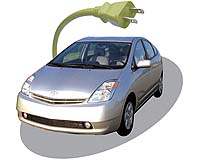 |
Amherst MA (SPX) Oct 28, 2009 Hydrogen fuel, because its only byproduct is steam, should be the ultimate in green alternatives to fossil fuels, but it hasn't delivered on its promise yet because of one enormous stumbling block, storage. Now a team of chemical engineers at the University of Massachusetts Amherst has developed a computational model that shows that carbon nanotubes may offer a surprising solution. Results are presented in the current online issue of the journal, Applied Physics Letters. "If this works as we expect, it's perhaps no longer science fiction to hope for a briefcase-sized hydrogen battery to run a bus or car," says UMass Amherst chemical engineering professor Dimitrios Maroudas. "Hydrogen storage has been a huge problem in the energy field for the past 10 years because no one has been able to demonstrate a truly viable storage medium. We've shown that it's possible to achieve hydrogen storage capacity up to 8 percent by weight using carbon nanotubes. This is an outstanding level, higher by 1 percent than the 2010 United States Department of Energy target for on-board hydrogen storage systems," Maroudas adds. "The method we propose may lead to breaking the bottleneck." The UMass Amherst computational model strongly lends itself to verification in laboratory experiments, say Maroudas and colleagues, and it provides ample testable hypotheses for future experimental research. "People had been losing faith, but I think our predictions show that hydrogen should be back on the table and in a most promising way. We come up with modeling predictions for technologically relevant problems every day, but this cute model is special," he notes. Specifically, Maroudas, his graduate student Andre Muniz and their collaborator M. Meyyappan, chief scientist for exploration technology at the Center for Nanotechnology at NASA Ames Research Center, Moffett Field, Calif., show that proper arrangement of carbon nanotubes can overcome hydrogen transport limitations in nanotube bundles. It should also prevent ineffective and nonuniform hydrogenation, which is caused by nanotube swelling due to chemisorption of hydrogen atoms on the nanotube walls. If one were to think of carbon nanotube bundles as something like a toothbrush, one strategy that Maroudas and colleagues recommend for holding hydrogen atoms most efficiently is that the brush arrangement should not be too dense. If it is, when the tubules swell they'll block efficient passage and diffusion of the hydrogen, Maroudas explains. In addition to an optimal bundle density, further improvement can be achieved by optimizing the individual nanotube configurations to limit their swelling upon hydrogenation. Following this approach should result in one hydrogen atom being able to chemisorb onto - form a chemical bond with - each carbon atom of the nanotubes, leading to 100 percent (atomically) storage capacity, he adds. This chemisorbed hydrogen, bound to the surface, can then be easily released by applying heat. Maroudas says, "We propose recipes that will be very easy for others to try, by which carbon nanotubes can be arranged to accomplish practically 100 percent storage atomically, which is nearly 8 percent by weight. You can't get any greener than hydrogen as fuel, and if the experiments we envision lead to new technology that's economically viable, that's as good as it gets." This work was supported by a National Science Foundation grant and a Fulbright/CAPES scholarship to Muniz. Share This Article With Planet Earth
Related Links University of Massachusetts Amherst Car Technology at SpaceMart.com
 Costs Of Plug-In Cars Key To Broad Consumer Acceptance
Costs Of Plug-In Cars Key To Broad Consumer AcceptanceAnn Arbor MI (SPX) Oct 27, 2009 A University of Michigan survey shows widespread consumer interest in buying plug-in hybrid electric vehicles (PHEVs). But the cost of the cars is much more influential than environmental and other non-economic factors as a predictor of purchase probabilities. The survey of a nationally representative sample of 2,513 adults age 18 and over was conducted between July and November 2008 as ... read more |
|
| The content herein, unless otherwise known to be public domain, are Copyright 1995-2009 - SpaceDaily. AFP and UPI Wire Stories are copyright Agence France-Presse and United Press International. ESA Portal Reports are copyright European Space Agency. All NASA sourced material is public domain. Additional copyrights may apply in whole or part to other bona fide parties. Advertising does not imply endorsement,agreement or approval of any opinions, statements or information provided by SpaceDaily on any Web page published or hosted by SpaceDaily. Privacy Statement |